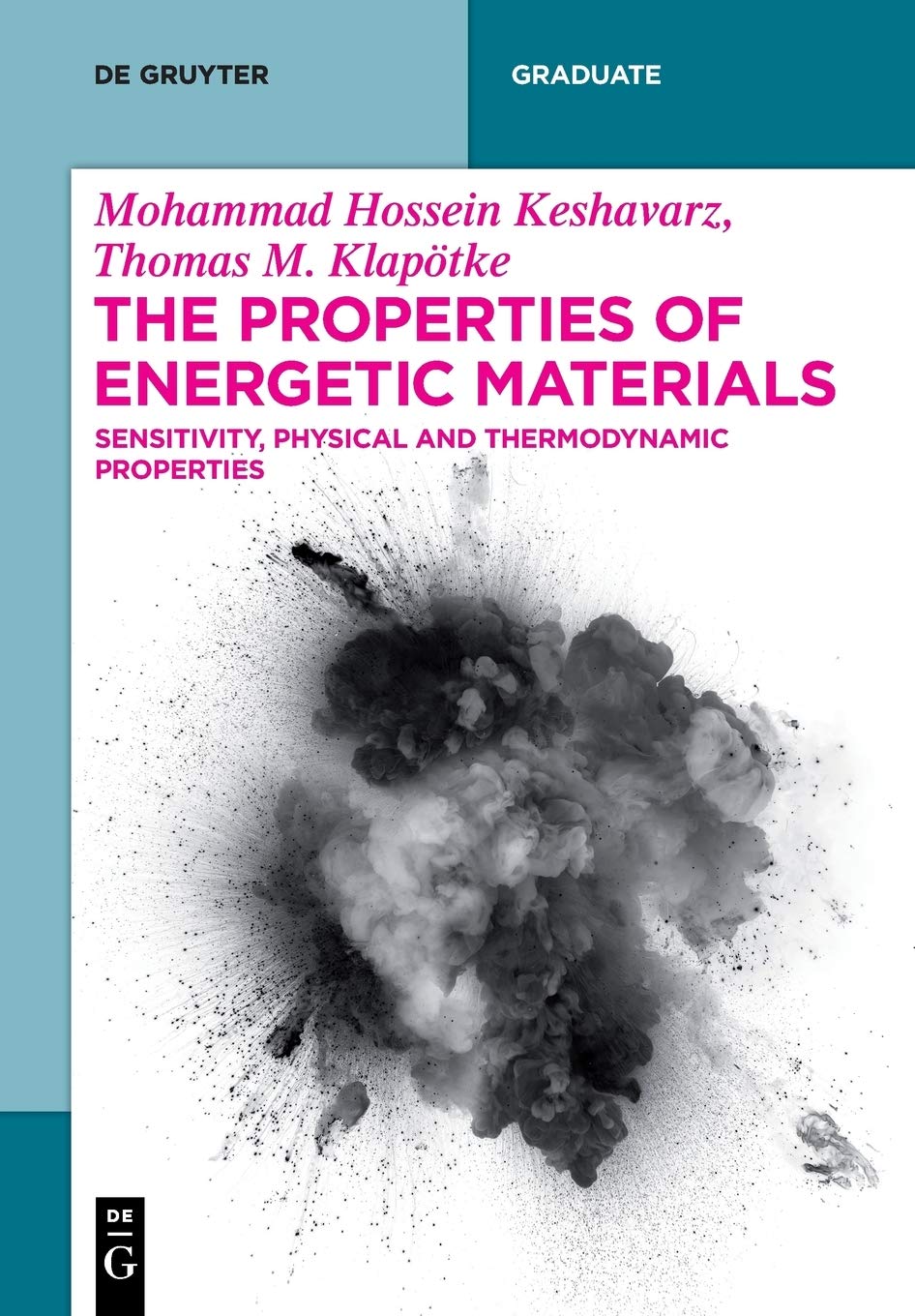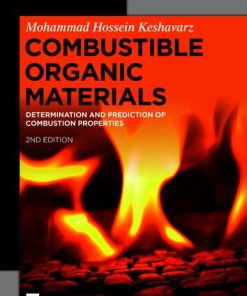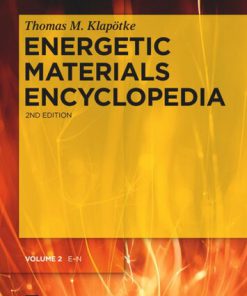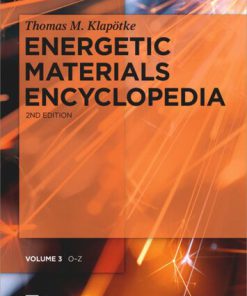The Properties of Energetic Materials de Gruyter Textbook 1st Edition by Mohammad Hossein Keshavarz, Thomas Klapotke 3110521873 9783110521870
$50.00 Original price was: $50.00.$25.00Current price is: $25.00.
The Properties of Energetic Materials de Gruyter Textbook 1st Edition by Mohammad Hossein Keshavarz, Thomas Klapotke – Ebook PDF Instant Download/Delivery: 3110521873, 9783110521870
Full download The Properties of Energetic Materials de Gruyter Textbook 1st Edition after payment

Product details:
ISBN 10: 3110521873
ISBN 13: 9783110521870
Author: Mohammad Hossein Keshavarz; Thomas M. Klapötke
For a chemist who is concerned with the synthesis of new energetic compounds, it is essential to be able to assess physical and thermodynamic properties, as well as the sensitivity, of possible new energetic compounds before synthesis is attempted. Various approaches have been developed to predict important aspects of the physical and thermodynamic properties of energetic materials including (but not limited to): crystal density, heat of formation, melting point, enthalpy of fusion and enthalpy of sublimation of an organic energetic compound. Since an organic energetic material consists of metastable molecules capable of undergoing very rapid and highly exothermic reactions, many methods have been developed to estimate the sensitivity of an energetic compound with respect to detonationcausing external stimuli such as heat, friction, impact, shock and electrostatic discharge. This book introduces these methods and demonstrates those methods which can be easily applied.
The Properties of Energetic Materials de Gruyter Textbook 1st Table of contents:
1 Crystal density
1.1 Quantum mechanical approach
1.2 Empirical methods for the calculation of the crystal density of different classes of energetic materials
1.2.1 Nitroaromatic energetic compounds
1.2.2 Acyclic and cyclic nitramines, nitrate esters and nitroaliphatic compounds
1.2.3 Improved method for the prediction of the crystal densities of nitroaliphatics, nitrate esters and nitramines
1.2.4 Reliable correlation for the prediction of the crystal densities of polynitro arenes and polynitro heteroarenes
1.2.5 The extended correlation for the prediction of the crystal density of energetic compounds
1.2.6 Energetic azido compounds
1.3 Empirical methods for the assessment of the crystal density of hazardous ionic molecular energetic materials using the molecular structures
1.3.1 Two general empirical methods
1.3.2 The effects of various substituents on the density of tetrazolium nitrate salts
2 Heat of formation
2.1 Condensed and gas phase heats of formation of energetic compounds
2.1.1 QM, MM and GA approaches
2.1.2 Empirical approaches or QSPR methods on the basis of structural parameters
2.2 Energetic compounds with high nitrogen contents
2.2.1 Using the molecular structure
2.2.2 Gas phase information
3 Melting point
3.1 GAV, QSPR and quantum mechanical methods
3.2 Simple empirical methods on the basis of molecular structure
3.2.1 Nitroaromatic compounds
3.2.2 Polynitro arene and polynitro heteroarene compounds
3.2.3 Nitramines, nitrate esters, nitrate salts and nitroaliphatics
3.2.4 Nonaromatic energetic compounds
3.2.5 Improved method for predicting the melting points of energetic compounds
3.2.6 Organic molecules containing hazardous peroxide groups
3.2.7 Organic azides
3.2.8 General method for the prediction of melting points of energetic compounds including organic peroxides, organic azides, organic nitrates, polynitro arenes, polynitro heteroarenes, acyclic and cyclic nitramines, nitrate esters and nitroaliphatic compounds
4 Enthalpy and entropy of fusion
4.1 Different approaches for the prediction of the enthalpy of fusion
4.1.1 Nitroaromatic carbocyclic energetic compounds
4.1.2 Nitroaromatic energetic compounds
4.1.3 Nonaromatic energetic compounds containing nitramine, nitrate and nitro functional groups
4.1.4 Improved method for the reliable prediction of the enthalpy of fusion of energetic compounds
4.1.5 A reliable method to predict the enthalpy of fusion in energetic materials
4.2 Different methods to predict the entropy of fusion
5 Heat of sublimation
5.1 Quantum mechanical and complex approaches for predicting the heat of sublimation
5.2 The use of structural parameters
5.2.1 Nitroaromatic compounds
5.2.2 Nitramines
5.2.3 Nitroaromatics, nitramines, nitroaliphatics and nitrate esters
5.2.4 General method for polynitro arenes, polynitro heteroarenes, acyclic and cyclic nitramines, nitrate esters, nitroaliphatics, cyclic and acyclic peroxides, as well as nitrogen-rich compounds
6 Impact sensitivity
6.1 Complex methods
6.2 Simple methods on the basis of molecular structure
6.2.1 Oxygen balance correlations
6.2.2 Elemental composition and molecular moieties
7 Electric spark sensitivity
7.1 Measurement of electric spark sensitivity
7.2 Different methods for predicting electric spark sensitivity
7.3 Simple methods for predicting electrostatic spark sensitivity
7.3.1 Polynitroaromatic compounds
7.3.2 Cyclic and acyclic nitramines
7.3.3 General correlation for polynitroaromatics as well as cyclic and acyclic nitramines
7.4 Some aspects of predictive methods
8 Shock sensitivity
8.1 Small-scale gap test
8.2 Large-scale gap test
9 Friction sensitivity
10 Heat sensitivity
10.1 Thermal kinetics correlations
10.1.1 Nitroparrafins
10.1.2 Nitramines
10.1.3 Polynitro arenes
10.1.4 Organic energetic compounds
10.2 Heat of decomposition and temperature of thermal decomposition
10.2.1 Heat of decomposition of nitroaromatics
10.2.2 Heats of decomposition of organic peroxides
10.2.3 Onset and maximum loss temperatures
10.3 Deflagration temperature
10.3.1 F+ nonadd
10.3.2 F- nonadd
10.3.3 Energetic compounds containing both F+ nonadd and F- nonadd
11 Relationships between different sensitivities
11.1 Relationship between impact sensitivity of energetic compounds and activation energies of thermal decomposition
11.1.1 Nitroaromatics
11.1.2 Nitramines
11.2 Relationship between electric spark sensitivity and impact sensitivity of nitroaromatics
11.3 Relationship between electric spark sensitivity and activation energy of the thermal decomposition of nitramines
11.4 Correlation of the electrostatic sensitivity and activation energies for the thermal decomposition of nitroaromatics
11.5 Relationship between the activation energy of thermolysis and friction sensitivity of cyclic and acyclic nitramines
People also search for The Properties of Energetic Materials de Gruyter Textbook 1st:
energetic materials definition
introduction to energy mastery test edmentum
7 properties of materials
3 physical properties of mercury element
Tags:
Mohammad Hossein Keshavarz,Thomas Klapotke,Properties,Energetic
You may also like…
Uncategorized
Chemistry - Inorganic Chemistry
Chemistry - Technical & Industrial Chemistry
Energetic Materials Encyclopedia 2 ed in 3 vol V 2 E N Klapötke Thomas M
Chemistry - Organic Chemistry
Computers - Computer Science
Analog Computing De Gruyter Textbook 2nd Edition Bernd Ulmann
Chemistry - Technical & Industrial Chemistry
Energetic Materials Encyclopedia 2 ed in 3 vol V 1 A D Klapötke Thomas M
Computers - Computer Graphics & Design
Analog Computing De Gruyter Textbook 2nd Edition by Bernd Ulmann 311078761X 9783110787610
Chemistry - Technical & Industrial Chemistry
Energetic Materials Encyclopedia 2 ed in 3 vol V 3 O Z Klapötke Thomas M











